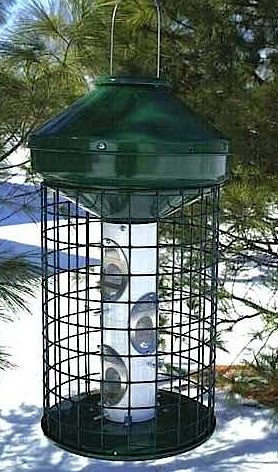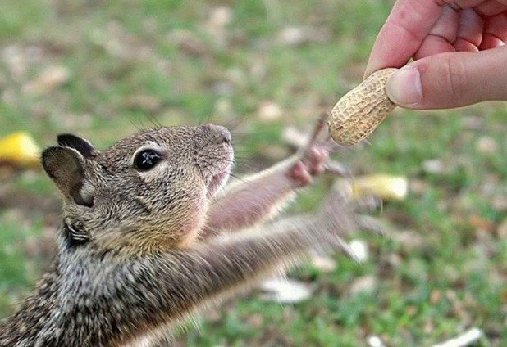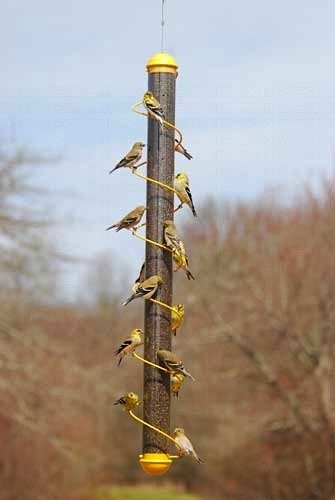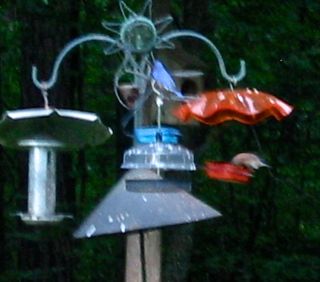- Bird Feeders, Squirrel Proof Bird Feeder, Squirrel Proof Bird Feeders, Tube Bird Feeder, Uncategorized, Wild Bird Feeders
super squirrel proof bird feeders
If you’re a little bird-crazy like us, keeping feeders filled is a priority that takes time – in fact it’s a daily chore lately due to some bully birds hanging around the yard. Only filling feeders about one quarter of capacity, because no matter what’s offered… it’s gone in a few hours! And we’re not even talking squirrels here… grackles, starlings and doves are the culprits. Isn’t it time for them to move on yet?
Because squirrels are enough menace in their own right, every single bird feeder has a baffle on it, even bluebird houses have baffles to protect nests from curious paws. But outwitting the critters really isn’t as difficult as some may think. Squirrel Proof Bird Feeders with cages like this are very effective against both squirrels and larger, less desirable birds. Some of the caged feeders are let’s say, kind of cheesy, but this large capacity model is super quality and made in the USA. With a big three gallon capacity, and built in seed tray to catch waste, this super squirrel-resistant feeder even has an innovative design that makes it simple to fill and clean. The PVC feeder tube will never yellow like some of the acrylic tubes, and stainless steel feeder ports retain their shiny new look.
Don’t get us wrong… we feed the squirrels too, but somehow that’s never enough either. May be time to look into one of these for our own yard? And although a bit overboard with our wildlife habitat, that’s not really us feeding this furry friend – although it is kinda cute!
-
cool spirals on these big thistle feeders
It’s a busy time for American Goldfinches as they have one of the latest breeding/nesting cycles of most backyard birds. They’re also one of very few breeds who actually molt twice a year and grow new feathers. Their electric yellow plumage is hard to miss, and most thistle feeders are seeing a good bit of traffic right now (provided the seed hasn’t gone moldy from all the rain). If yours is sitting with no takers – best to dump old seed, clean the feeder and replace with fresh thistle seed.
Innovative by design with quality construction (no cheezy plastic parts here) these 36-inch tall, large capacity thistle feeders have a cool spiral instead of perches. Featuring more feeder ports, birds really do “run the spiral” hopping from one one port to the next. This opens up space for more birds to join the party, no more waiting around for an open perch to catch some chow!
Goldfinches feed babies thistle (or nyjer) exclusively. Gross as it sounds, parents chew and prepare the tiny black seed, regurgitating it into babies’ mouths. It’s not until juveniles are out in the world that they may start to discover and eat insects. There’s a kind and quiet demeanor about this favored songbird, you’ll rarely catch them squabble at feeders. Rather than fight for a spot, most will give up and maybe try again later. Hanging a few economical thistle socks helps to alleviate this problem during peak season.
In fall when they molt again, their vibrant yellow plumage will give way to new olive drab feathers for fall and winter. It may seem like your Goldfinches have gone on their way and migrated south, but they’re still around! Keep thistle feeders out year-round to accommodate these resident birds, (and fresh water in a bath) and next summer that lemon yellow color will once again grace your yard. So popular these birds are, there’s even a birdhouse modeled after one… although typically they do nest in hedges or trees.
-
make room mr. tube bird feeder
Fuzzy picture but great subject matter! That’s Mr. and Mrs. Bluebird again, and tonight they coaxed their babies to the feeders. Of five fledges, two are out and about so far, and mom and dad have claimed the same house for nesting number two.
All those feeders hang from one garden pole, plus an extender branch (which hasn’t even made it to the website yet). They’re great for hanging additional smaller items and give birds lots of perching space around feeders. Last year a small hanging bath was added to the branch. What are all those feeders, and do you think anymore would possibly fit on this pole? Three dishes for mealworms… they’re most popular this time of year as everyone is feeding babies! Cardinals, Catbirds, Nuthatches, Chickadees, Titmice, Phoebes, Carolina Wrens, and of course… the bluebirds. The meal worm grower loves me 🙂 The dark little cup… jelly for the Catbirds. And of course the cone shaped squirrel baffle, it’s a must on every feeder pole around the yard!
The silver silo, or tube bird feeder sees little activity as compared to the worm dishes. It’s filled with Finch Mix, but Goldfinches seem to prefer straight thistle this time of year. Why? Babies! Their diet is pretty exclusive to the tiny black nyjer seed. Another tube feeder containing shelled peanuts is seeing some action, but the worms win hands down!
And speaking of tube bird feeders – have you seen the spiral ones? They’re way cool as more birds get to perch and eat at once. The tubes feature an “all-over” feeding area, and the spiral allows birds to land and eat anywhere on the feeder. No more waiting for an open perch. Available for peanuts, thistle, or mixed seed.
Next time you’re in the grocery store, pick up some grape jelly for the birds. That dish is actually a glass votive holder, but works great for offering jelly too. And don’t forget the oranges as Orioles love them too. Spring may have sprung a little late this year, but the bird show is definitely on!






